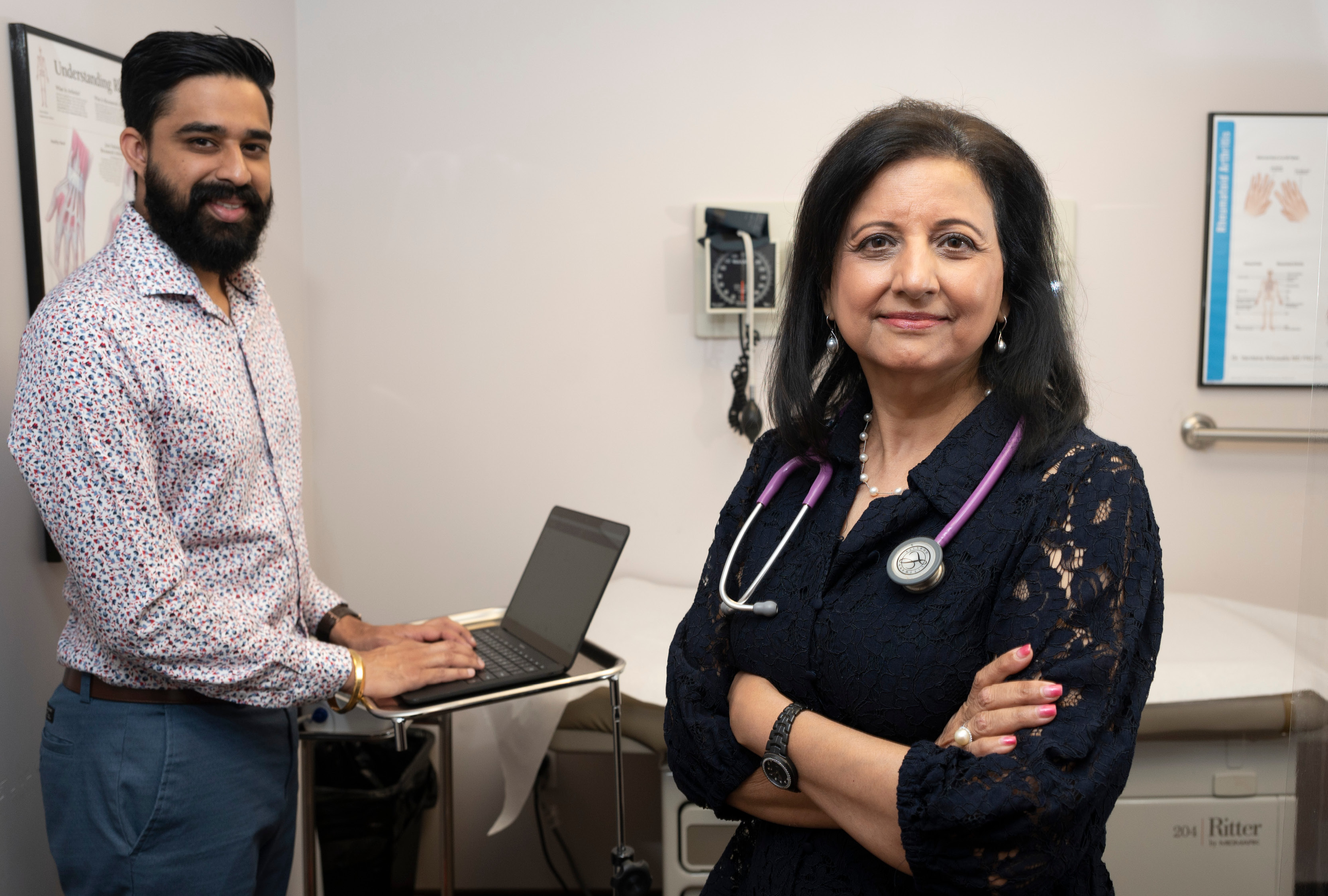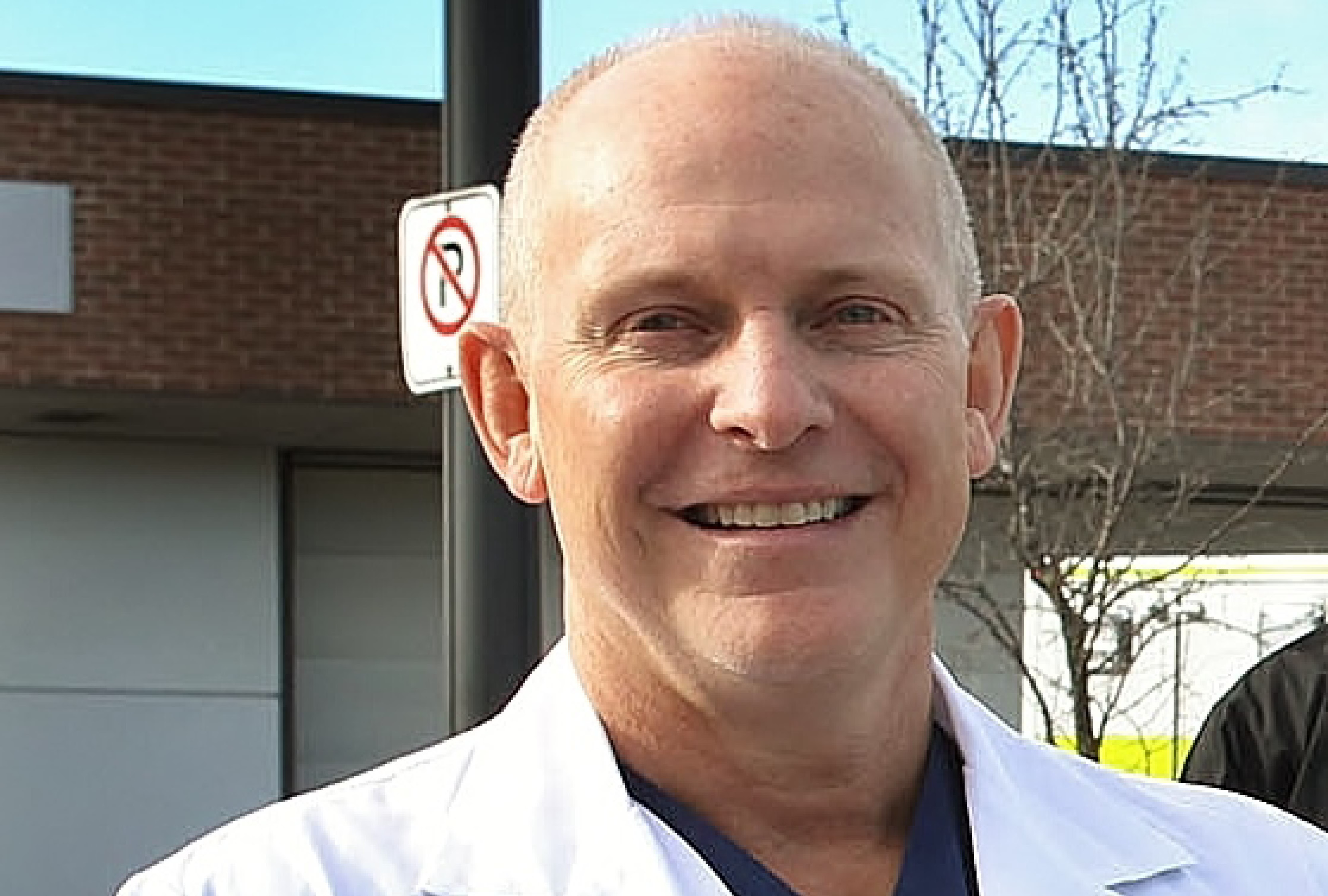This article originally appeared in the Fall 2022 issue of the Ontario Medical Review magazine.
Understanding the benefits of scribes in a doctor’s practice
When Dr. Vandana Ahluwalia hired a medical scribe to assist in her rheumatology clinic, it was to claim back a piece of her life.
The idea arose while brainstorming with a friend on how to improve her practice. For Dr. Alhuwalia, past chief of rheumatology at William Osler Health System and past president of the Ontario and Canadian Rheumatology Associations, it came down to freeing herself from paperwork, which was taking a toll on her well-being.
“I was getting to the point where things were becoming overwhelming,” she explained. “I said something has to change…when my friend asked, ‘What do you need?’ I told her ‘I think I need a scribe’.”
The search was on and within a few weeks, Dr. Ahluwalia had hired a master’s of cell and stem biology graduate, who was looking for rewarding work. “He’s been with me for three years and it’s been a fantastic relationship,” she said.
Medical scribes, like Dr. Ahluwalia’s, assume tasks such as real-time transcription of doctor-patient interactions, recording patient history and updates, exam results or follow-up appointment details. Notes are reviewed by the physician for relevancy and accuracy.

“Ultimately, the physician is responsible for everything that is written down,” said Dr. Peter Graves, an emergency physician at Ottawa’s Queensway Carleton Hospital and co-founder of Medical Scribes of Canada, a company that runs medical scribe programs in emergency departments and in inpatient and outpatient wards. “A scribe cannot have any direct patient contact.” Dr. Graves added that Medical Scribes of Canada have been focusing on emergency departments more than outpatient clinics though they have had some limited experience in the past outside of the emergency department.
The use of scribes – who first appeared in U.S. emergency departments in the 1970s – is on the rise as electronic medical records contribute to clerical and administrative workloads. The Ontario Medical Association’s 2021 Burnout Task Force report referenced a 2020 survey of Nova Scotia physicians that found that doctors there spent 10.6 hours a week on administrative work.
Dr. Vandana Ahluwalia (right), past chief of rheumatology at William Osler Health System and past president of the Ontario and Canadian Rheumatology Associations, hired Dilnoor Sidhu to work as her medical scribe three years ago. At that time, Dr. Ahluwalia was experiencing an overwhelming paperwork burden in her rheumatology practice.
This administrative/clerical burden is a common complaint amongst physicians. A 2022 PubMed study showed that the hours spent on EMR documentation resulted in lost autonomy and work-life balance while contributing to cognitive fatigue. The number one solution recommended in the OMA’s Burnout Task Force report was to assess documentation and administrative requirements, evaluating burden, complexity, redundancy and value to patient care. Both reports recommend using medical scribes to improve efficiencies and reduce burnout.
Evidence suggests that scribes can do just this. A 2017 Annals of Family Medicine study showed that using scribes improved physician satisfaction, including increasing time spent with patients, reducing time spent charting and improving charting accuracy. Medical Scribes of Canada’s pilot project in 2015 concluded that almost 82 per cent of physicians using a scribe saw approximately 13 per cent more patients per hour.
 “Within four months, we were able to demonstrate improved efficiency of patients seen by physicians, not to mention a complete offloading of their administrative tasks that were contributing to the burnout they were experiencing on shift,” said Stephen Graves, also a co-founder of Medical Scribes of Canada (and son of Dr. Graves).
“Within four months, we were able to demonstrate improved efficiency of patients seen by physicians, not to mention a complete offloading of their administrative tasks that were contributing to the burnout they were experiencing on shift,” said Stephen Graves, also a co-founder of Medical Scribes of Canada (and son of Dr. Graves).
An estimated 100,000 medical scribes are currently employed in the United States, with certifications available and recruitment companies in operation. In Canada, however, medical scribes aren’t as common. Companies, such as Medical Scribes of Canada and ScribesCanada, offer scribe recruitment and training services, and courses are available through some private educational institutions and colleges. But their reach remains limited without further integration into Canada’s public health-care system.
Dr. Peter Graves is an emergency physician at Ottawa’s Queensway Carleton Hospital and co-founder of Medical Scribes of Canada, a company that runs medical scribe programs in emergency departments and in inpatient and outpatient wards.
“There really isn’t a turnkey solution at this point in time in Canada for a physician to hire a scribe into their practice,” Stephen Graves added. “From what we’ve seen…it really does require a cohort of medical scribes to gather the momentum to keep a program running.”
Training a scribe varies depending upon the skills required, professional experience and the physician’s speciality. Broadly, it can encompass clinical practice and medical terminologies, privacy obligations, professional liability and workplace safety, Dr. Graves said.
“There certainly needs to be other safeguards put in place to ensure that confidentiality agreements are met,” he said.
It took Dr. Ahluwalia, who is a peer leader with OntarioMD, about a year to train her scribe. “I started from scratch. I did not have a training program for my scribe. I trained him myself and it took a long time to get him to the point where I felt he was doing a pretty good job.” Scribes, she added, come with varying experience, be they high school graduates or medical school students, and they may be with a practice temporarily before moving on or returning to school. Training and resources need to be adapted based on the scribe’s background and their knowledge of the physician’s practice or specialty.
To combat problems associated with turnover, Dr. Ahluwalia, who is now developing a training program to get scribes up and running within three months, recommends ensuring that current scribes reach a competency level to train the next hire. At Medical Scribes of Canada, for example, scribes who complete their requisite hours become training supervisors to prep future scribe cohorts.
“Very quickly they recognize that the merits of a scribe providing that service has enabled them to continue to focus on actual patient care, which is why we went into medicine in the first place.” — Dr. Peter Graves
 During the Medical Scribes of Canada project, few patients declined to have a scribe present during an exam and patient feedback was generally positive.
During the Medical Scribes of Canada project, few patients declined to have a scribe present during an exam and patient feedback was generally positive.
Physicians must obtain patient consent prior to having a scribe present, in-person or virtually, and respect a patient’s right to refuse, while also communicating clearly what the scribe’s role is, said Dr. Noah Crampton, a family physician with the Toronto Western Family Health Team and peer leader with OntarioMD. It must be clearly explained to patients the purpose of the scribe, particularly for patients who aren’t comfortable sharing their health information with anyone but their doctor, he explained.
Dr. Noah Crampton is a family physician with the Toronto Western Family Health Team and peer leader with OntarioMD, a wholly-owned subsidiary of the OMA that supports physicians in adopting digital health technology.
This includes acknowledging and reassuring the patient that their privacy, verbally expressed and in notetaking, will be maintained, added Dr. Graves.
The associated costs assumed by the physician are a major deterrent to hiring a medical scribe, noted Dr. Crampton, who alongside Dr. Ahluwalia, recently co-hosted an OMD Educates webinar, Hiring a Scribe Could Change the Way You Practice. He recommends weighing what the scribe will provide against the investment, finance- and resource-wise. Assess how their presence will impact a practice’s processes and workflow, staff and patient relations, and estimate how much time will be invested in training and reviewing notes after each patient interaction.
Dr. Ahluwalia acknowledged that scribes inevitably cost a practice – with rates ranging from $15 to $27 an hour – but physicians should consider how the benefits can offset the expense. Sharing scribes with other physicians can also reduce the cost for each individual doctor, she notes.
Dr. Graves added that the feedback he’s received from physicians working with a scribe suggests it’s worth the investment. “Very quickly they recognize that the merits of a scribe providing that service has enabled them to continue to focus on actual patient care, which is why we went into medicine in the first place.”
As the demand for medical scribing grows and technology evolves, machine learning could be part of the solution. Artificial intelligence medical scribing tools can alleviate some of the challenges of human scribes, including cost, training and turnover, said Dr. Crampton, who is also the founder and CEO of Toronto-based Mutuo Health Solutions, which has developed an AI tool called AutoScribe.
These tools, unlike typical dictation software, are increasingly able to interpret data, directly transcribing the doctor-patient interaction, while deciphering language nuances exchanged and how that corresponds with the medical note, explained Dr. Crampton.
Accuracy increases over time as the tool evolves and adapts to a physician’s clinical questions and edits, he added.
“The AI tool will never quit. It will never leave your practice. It will continually learn,” explained Dr. Crampton. “It will continue to improve and to become more tailored to your practice and be a net positive to your admin-burden pain point.”
Although AI tools would be beneficial from an administrative capacity standpoint, Stephen Graves raised the additional challenge of integrating these technologies and ensuring that they are sophisticated enough to handle the confidentiality issues around big data, particularly in the health-care sector. Rather than a takeover, he foresees AI and human scribes working together to maintain consistency and accuracy as physicians transition to full AI solutions.
"The AI tool will never quit. It will never leave your practice. It will continually learn." — Dr. Noah Crampton
Meantime, Dr. Crampton says the concerns with confidentiality have been addressed more widely than is currently known and suggests physicians review all the literature available to ensure they’re making the best decision for them, their practice and their patients.